The Intel Ivy Bridge (Core i7 3770K) Review
by Anand Lal Shimpi & Ryan Smith on April 23, 2012 12:03 PM EST- Posted in
- CPUs
- Intel
- Ivy Bridge
Discrete GPU Gaming Performance
Gaming performance with a discrete GPU does improve in line with the rest of what we've seen thus far from Ivy Bridge. It's definitely a step ahead of Sandy Bridge, but not enough to warrant an upgrade in most cases. If you haven't already made the jump to Sandy Bridge however, the upgrade will do you well.
Dragon Age Origins
DAO has been a staple of our CPU gaming benchmarks for some time now. The third/first person RPG is well threaded and is influenced both by CPU and GPU performance. Our benchmark is a FRAPS runthrough of our character through a castle.
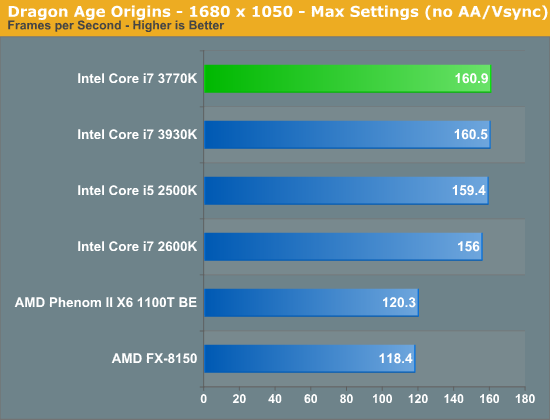
Dawn of War II
Dawn of War II is an RTS title that ships with a built in performance test. I ran at Ultra quality settings at 1680 x 1050:
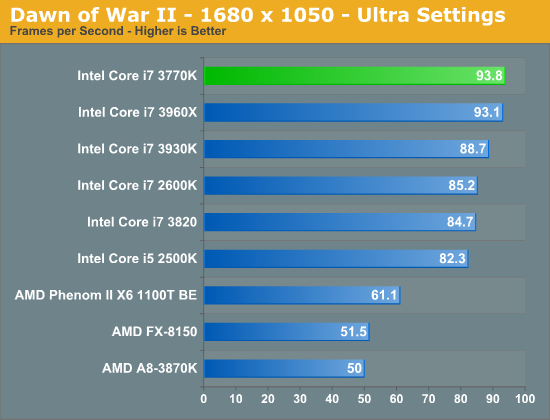
World of Warcraft
Our WoW test is run at High quality settings on a lightly populated server in an area where no other players are present to produce repeatable results. We ran at 1680 x 1050.
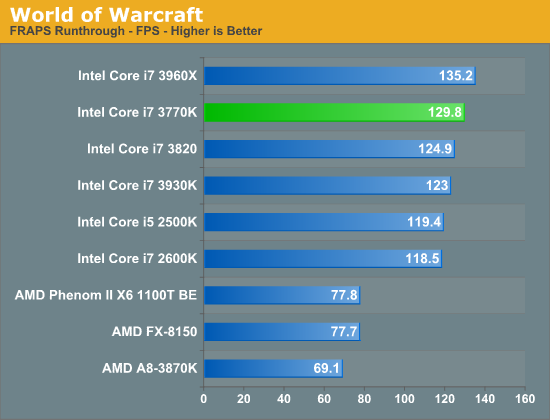
Starcraft 2
We have two Starcraft II benchmarks: a GPU and a CPU test. The GPU test is mostly a navigate-around-the-map test, as scrolling and panning around tends to be the most GPU bound in the game. Our CPU test involves a massive battle of 6 armies in the center of the map, stressing the CPU more than the GPU. At these low quality settings however, both benchmarks are influenced by CPU and GPU. We'll get to the GPU test shortly, but our CPU test results are below. The benchmark runs at 1024 x 768 at Medium Quality settings with all CPU influenced features set to Ultra.
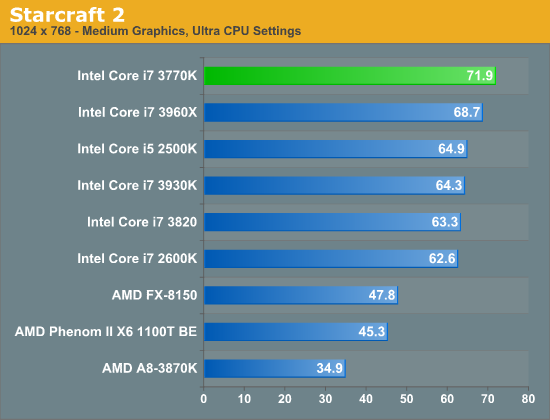
Metro 2033
We're using the Metro 2033 benchmark that ships with the game. We run the benchmark at 1024 x 768 for a more CPU bound test as well as 1920 x 1200 to show what happens in a more GPU bound scenario.

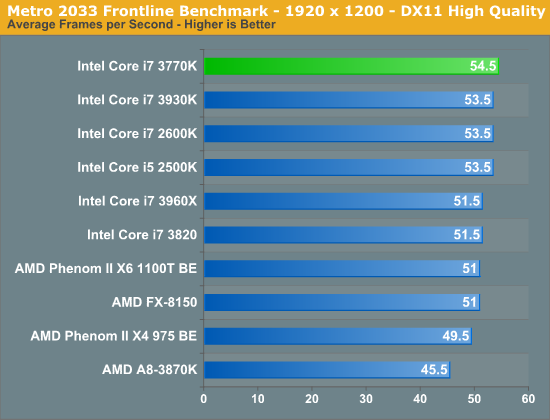
DiRT 3
We ran two DiRT 3 benchmarks to get an idea for CPU bound and GPU bound performance. First the CPU bound settings:
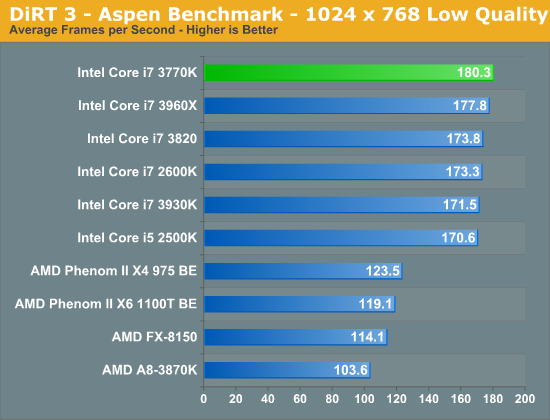
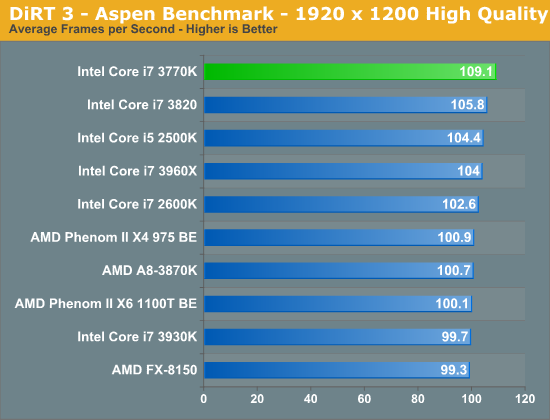
Crysis: Warhead
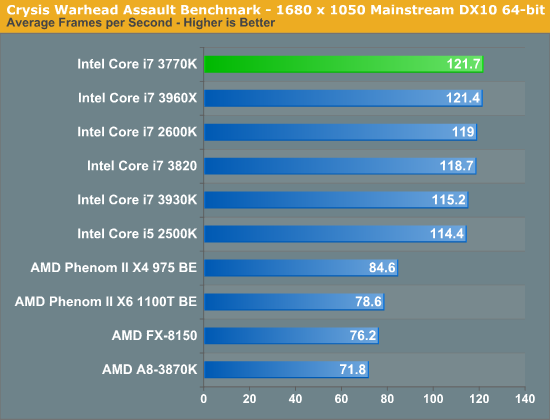
Civilization V
Civ V's lateGameView benchmark presents us with two separate scores: average frame rate for the entire test as well as a no-render score that only looks at CPU performance. We're looking at the no-render score here to isolate CPU performance alone:
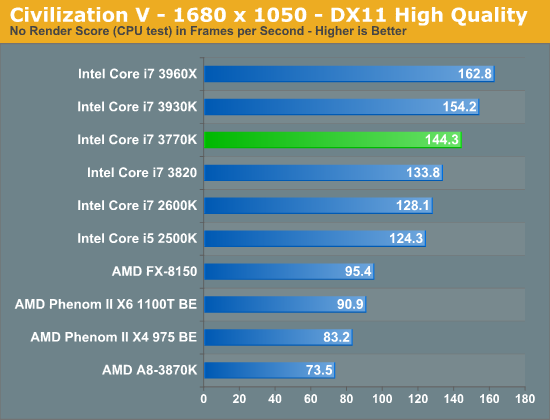










173 Comments
View All Comments
cjb110 - Tuesday, April 24, 2012 - link
Considering that on most games both the Xbox and PS 3tend to be sub 720p, the iGPU in Ivy Bridge is impressive. Has anybody compared the 3?tipoo - Tuesday, April 24, 2012 - link
You have a unified shader GPU with similar performance to the x1900 series but more flexible, and something like a Geforce 7800 with some parts of the 7600 like lower ROPs and memory bandwidth...7 years later, if even an IGP didn't beat those, it would be pretty sad. Those were ~200gflop cards, todays top end is over 3000, a lower-mid range chip like this I would expect to be in the upper hundreds.gammaray - Tuesday, April 24, 2012 - link
Why do Intel and AMD even started building IGPs in the first place?Why can't they just put a video card in every desktop and laptop?
And if they continue making IGPs, whats their goal?
Do they eventually wanna get rid of video card makers?
versesuvius - Tuesday, April 24, 2012 - link
Better yet, why not just put the graphics on a chip like the CPU? That way the "upgrade path" is a lot clearer, not to mention "possible". It will also offer the possibility of having those chips in different flavors, for example good video transcoder or good gamer. There is room for that on the motherboard now that the north bridge is gone. Or they can review the IBM boards from 286 days and learn from their clean, and very efficient design.Unfortunately the financial model of the IT industry from a collective viewpoint entails throwing a lot of good hardware away just for a small advantage. Just the way many will throw away their HD3000 IGPs without having ever used it. The comparison is cruel but that should not be what distinguishes them from the toilet paper industry.
As of late, Anand has taken to reminding us that technology has taken leaps ahead of our wishes and that we need time to absorb it. That is not the case. No wish is ever materialized. We only have to take whatever is offered and marvel at the only parameter that can be measured: speed. Less energy consumption is fine, but I suppose that comes with the territory (i.e. can Intel or AMD produce 22 nm chips that consume the same watts as 65 nm chips with the same number of transistors?).
tipoo - Wednesday, April 25, 2012 - link
Cost, size, power draw. All reduced by putting everything on one chip. I'm not sure if AMD wants to get rid of discreet graphics cards considering that's their one profitable division, but Intel sure does :)klmccaughey - Tuesday, April 24, 2012 - link
I've tried every setup possible and have never got quicksync to work at all. It won't even work with discrete graphics enabled and my monitor hooked up to the intel chip on my Z68 board.I have tried mediacoder (error 14), media converter 7, MEdia Espresso. I have downloaded the media SDK, I have tried the new FFmthingy from the intel engineer. Nothing, nada. It has never ever worked. AMD media converter will convert a few limited formats that went out of fashion 5 years ago (of all my 1.5TB of video the only thing it would touch was old episodes of Becker).
All in all I have got nothing whatsoever from any video accelerated encoding and I have always had to go back to my tried and trusted handbrake.
I don't think it actually works - I've never heard of anyone getting it working and the forums on mediacoder are full of people who have given up.
klmccaughey - Tuesday, April 24, 2012 - link
*disabled (for discrete graphics)JarredWalton - Tuesday, April 24, 2012 - link
What input format are you using? I've only tried it on laptops, and I've done MOV input from my Nikon D3100 camera with no issues whatsoever. I've also done a WMV input file (the sample Wildlife.WMV file from Windows 7) and it didn't have any trouble. If you're trying to do a larger video, that might be an issue, or it might just be a problem with the codec used on the original video.dealcorn - Tuesday, April 24, 2012 - link
Intel has big eyes for the workstation graphics market and has had some success at the bottom of this market. Will IB's IGD advances enhance Intel's access to this market?chizow - Tuesday, April 24, 2012 - link
Hope you're not counting yourself, you've proven long ago your opinion isn't worth paying attention to.